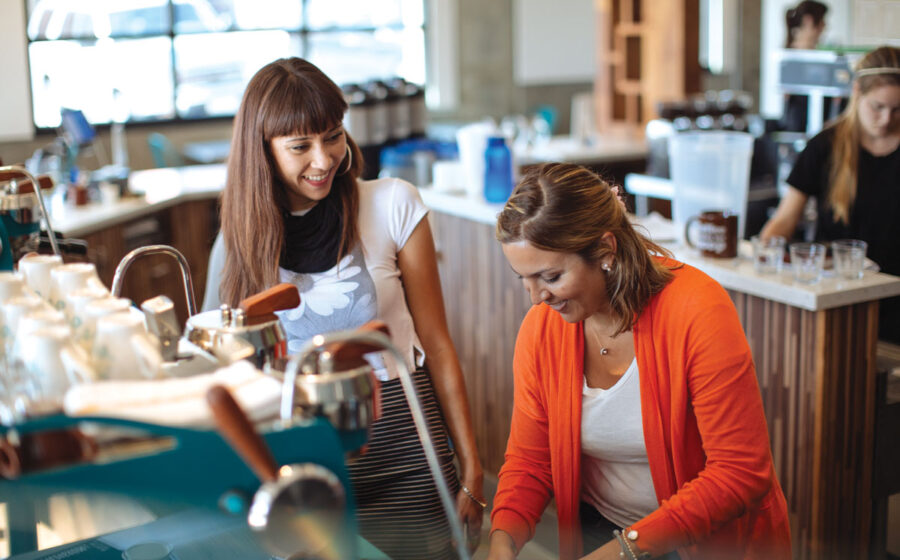[E]ver since coffee roasters began going to origin to source coffee directly from growers, there’s been debate and confusion about what direct trade looks like exactly. Trying to capture direct trade within a single definition tends to oversimplify the complexities of intrinsically personal coffee transactions. Rather than considering direct trade as a model that is tweaked as it’s applied to a given scenario, perhaps it is more accurate to think of direct trade in terms of a qualitative shift in the intentions behind trade, a shift that ultimately leads to direct relationships and direct communication no matter the varied logistics that underlie buying and selling coffee.
These relationships and communications are often discussed from the point of view of downstream stakeholders in consuming countries buying coffee from farmers and traveling to the source at origin. Truly direct trade functions in this direction and in the reverse; it creates equal space for producers to actively sell coffee to roasters and follow their product all the way to its final destination.
Direct communication is the core of direct trade, but travel is about more than just face-to-face conversations; it’s about understanding the essence of a place.
Visiting origin is often a moving experience for roasters and baristas, an illuminating process that fosters holistic understanding of the complexities behind coffee. Traveling to coffee destinations in consuming countries is equally moving for producers; seeing customers lined up out the door of a café serving their coffee can change their perception of their importance to coffee. Producers are as eager as roasters to trace their harvests, and those who do demonstrate that in direct-trade, travel, like communication, flows both ways.
Case Study 1: Marianela Montero and Sound Coffee Collective
Sound Coffee Collective, based in Riverside, California, is a new company dedicated to providing farmers with digital marketing materials and tools to promote themselves and their coffees in a direct-trade market. Rather than set up the collective as a non-profit dependent on fluctuating donations, founder Miah Idema opted to establish an LLC, selling roasted coffee purchased from the farmers Sound works with to generate revenue for future projects.
While traveling in Costa Rica in 2014, Idema volunteered on coffee farms in Tarrazu that belonged to brothers Carlos and Manuel Montero. He was inspired by the dedication the brothers and their families had poured into building a micro-mill to process their coffee and those of neighboring farms. “Their work ethic and their life stories completely altered my view of reality,” says Idema. He was inspired by their resilience and connection to their land and their work. “My generation has lost that connection to how things were made. My passion is for people, for learning the ways we think and how we do things.”
As a farmer’s kid, I knew there were nice cafés and I heard about barista competitions, but to be at the SCAA Event and see the whole community of people from all over is a world of coffee I never imagined.
Knowing that origin is such a powerful, almost mythical, concept in the industry, Idema wanted to share, through videos and podcasts, farmers’ perspectives of coffee, work, and life with consumers and coffee professionals, to show that origin visits can do more than source hyper-specialty coffee. The trips are a chance to discover new perspectives and values surrounding things that can often get lost in the bustle of life in consuming countries, things like environmental stewardship, family collaboration, and respect for grueling physical labor.
“What I have come to understand from the Monteros is that success is not a given,” says Idema. Through story sharing and coffee selling, Sound Coffee Collective aims to offer what its name embodies, both coffee and information that are sound in intention and practice.
Idema’s origin trip to Costa Rica precipitated a destination trip going the opposite direction. Carlos Montero’s daughter Marianela, who goes by Nela, traveled to Idema’s home in California, the first step in what would become a year-long odyssey across the US, Australia, and Europe to understand consumer coffee culture from the perspective of a producer. Nela was able to see her family’s coffee served in cafés, and she completed barista apprenticeships along with a three-month internship at Bodhi Leaf Coffee Traders, which imports her uncle’s coffee.
“I have learned to love the other side, the side we have no knowledge of,” says Nela. “As a farmer’s kid, I knew there were nice cafés and I heard about barista competitions, but to be at the SCAA Event and see the whole community of people from all over is a world of coffee I never imagined.”
I am so picky with my coffee, and it’s like they are taking care of my baby!
Nela shared her experiences via her blog, Cafeticainela, showing what the other side of the coffee industry looks like to someone who grew up picking coffee during school vacations. Coffee shop culture is budding but still limited in Central America, and Nela was taken with all the details of design and aesthetic that North American and European customers tend to take for granted in their coffee shops and cafés. For Nela, every detail she observed in lighting, décor, furniture, layout, and barista dress communicated how much people love and care about the coffee they drink, and implied how much they value the farmers.
Back in Costa Rica, Nela is developing more ways to apply what she learned to her family’s farm, mill, and their nascent tourism operation. She is also imparting to the producer community the importance of careful decision making at the farm level, knowing how it impacts the final beverage served on the other side of the globe. “I am trying to focus on the next generations and motivate them to experiment more on the farms and to study more about soil and agronomy,” she says.
When information based on firsthand experience flows in both directions between farm and cup, trade becomes not only more direct but more equitable, with all parties able to see the shape of the whole chain and find the niche where they fit best.
Case Study 2: Anny Ruth Pimentel and Bird Rock Coffee Roasters
Producer Anny Ruth Pimentel of El Boquerón, El Salvador, began her relationship with Chuck Patton, the owner of Bird Rock Coffee Roasters in San Diego, through an e-mail. After reading an article he wrote, “I sent him a message commending it and the great transparency he has in his business,” she says. “He had already scheduled a trip to El Salvador to visit another supplier and contacted me to set up a visit.”
Patton has been a vocal educator regarding direct trade, and his travels prompted Pimentel to take a destination trip of her own. “As roasters do origin trips to learn about coffee, I’m doing an origin trip backwards,” she says. “I get to know the customers to see what they think about the coffee so that I can deliver an improved cup.”
To come and be celebrated was not what I expected. I am just the person who grows the beans!
Pimentel had the chance to sample roast and work behind the bar as a barista at Bird Rock, and see how attributes like bean density and size translate from the farm through to the final drink. Pimentel’s father built a processing mill on his farm eleven years ago, but due to a drop in prices never once operated it. “Two years ago I started processing coffee at the mill and looking for clients directly,” she says. “But for me it’s not just about a sale. That’s not what motivates me. It’s about the relationship. Who drinks the coffee? I’m looking to get that communication running all the way through the value chain so I can deliver something that is more to the taste of the customers.”
It can be nerve wracking for producers to discover the fate of their product. All their meticulousness at the farm can be negated with one careless extra minute of over-roasting or an under-extracted shot. But Pimentel was pleasantly surprised. “The way that I take care of my coffee at every step, Chuck and Jeff [Courson of Bodhi Leaf, who imports her coffee] take care of it just as carefully. I am so picky with my coffee, and it’s like they are taking care of my baby!” says Pimentel. As Courson says, direct trade is about building partnerships between people who have the same approaches and the same values to how they do business.
Patton adds that Pimentel’s visit to Bird Rock was as invaluable an experience for the staff as it was for her. Anny has assimilated into Bird Rock’s culture,” he says. “Instead of just seeing her name on the bag of beans they’re supposed to sell, the employees actually work with her. Next we’ll be sending four of our baristas to El Salvador to participate in an exchange.”
[E]xchange seems to be an appropriate word to use in discussing direct trade. In an exchange both sides offer and gain something valuable. Direct trade aims to make the coffee trade a more even exchange. When cafés, roasters, and importers open their doors as wide as producers have opened theirs (and this may mean bringing farmers over on the roaster’s dime), trade has truly become an equitable exchange where all parties are able to directly access the information that can inform their business choices and inspire long-term partnerships that will position producers to sustain and grow their operations.
“Both Anny and Nela got themselves here, now it’s my turn to return the gracious hospitality that I’ve been shown on our origin trips,” says Courson. When I have a supplier in town I do everything to show them as many specialty shops and roasteries as possible.”
For Pimentel, it was joyous to finally see the links in the chain that are typically mysterious to producers. “What has really moved me has been to see how consumers, roasters, baristas perceive us growers. Coffee is something I do on a daily basis, not because I have to, but because I love it. To come and be celebrated was not what I expected,” she says. “I am just the person who grows the beans! But it’s not just me; it’s them—they have done the rest.”
Direct trade exists in countless iterations, but ideally all are collaborations between people who know, trust, and respect each other. These qualities are hard to quantify, but Pimentel observes that direct trade is, more than anything else, something you can feel. “We visited lots of shops in LA that were beautiful and well-designed, but they lacked heart. When you walk into a place like Bird Rock or Bodhi Leaf you can tell right away that they care about and value who they are working with.”
The essence of direct trade is valuing people over product. Like all relationships, direct trade relationships thrive with investments in time and communication, particularly balancing time spent as a traveler and time spent as a host.
—Rachel Northrop is a New York City-based writer and the author of the ethnography When Coffee Speaks: Stories from and of Latin American Coffeepeople.


















